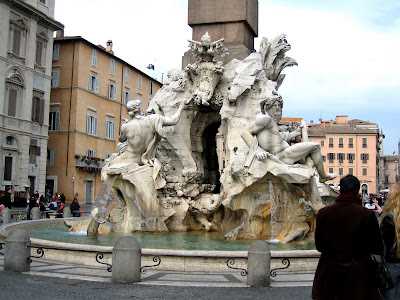Bernini's free-float obelisk
Metro line B; Colosseo to bus n. 87
The Piazza Navona is one of the most active and beautiful squares in Rome
The Piazza was designed on the site of an old stadium, the Domiziano Stadium, and therefor maintains a visually pleasing oval shape. Most people admire its beauty for its dynamic architecture and incredible fountains without realizing that they are looking at works of two of the great masters in art, Bernini and Borromini.
For the Leisurely Traveler: Remember the phrase, "No, e' troppo caro," when you're buying art in the market. The artists mean to bargain with you, so never accept their first price. This same phrase (literally translated as, "No, it's too dear") should be used when buying burned CDs, umbrellas, light-up toys, or roses from any of the number of street salesmen who will inevitably accost you while you are in Rome.
The oval shape of the piazza
Be sure to take notice of the layout of the piazza. This is a site which, unlike the Vatican and the Colosseum, maintains its Baroque design. Mussolini, in an effort to draw attention to the grandeur of Rome
For the information of the Leisurely Traveler: The piazza was commissioned by the Pamphilj family, or Pope Innocent X. The major work of art in the square, is the central of the three fountains, Bernini's Fountain of the Four Rivers. The first sculptural fountain ever, the Triton Fountain, was executed by Bernini, as well as was the Trevi Fountain, and using the added element of water to create a more dynamic sculpture is a very Baroque quality. The large figures that rest at the foot of the obelisk are the personifications of the four rivers (or four corners) of the world, the Danube, the River Plate, the Ganges and the Nile . The obelisk as a pagan symbol capped with the Pamphili dove represents the Vatican
Make sure to take notice of Bernini's obelisk. It seems to float, almost unattached to the base of the sculpture, and this is truly a tour de force, a daunting task accomplished by the master.
(photo from www.buffaloah.com)
Make sure to take notice of the Church of Sant' Agnese in Agone by Borromini. It was commissioned by Innocent X and influenced Baroque architecture with a fluted facade and dynamic appearance.
An interesting story: The church stands on the grounds of the brothel where St. Agnes was martyred. It is said that this thirteen year-old girl refused the Prefect's son, claiming she was married only to Christ, and so she was dragged through the streets naked, praying to the Lord, when her hair grew suddenly, maintaining her modesty.
For the Leisurely Traveler: If you are adventurous enough to try the buses, bus no. 87 will take you almost directly to the square, if not I suggest taking a cab to this spot. While there are free maps of Rome available all over the city, walking this city in general can be very hard on your feet. This square in particular, is especially hard to find, embedded deep in the meandering streets of the city and not near any major metro stop.




This comment has been removed by the author.
ReplyDelete